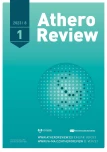RNA interference – new prospective direction in drug development
Authors:
Vladimír Soška 1,2; Ondřej Kyselák 1,3
Authors‘ workplace:
Oddělení klinické biochemie FN U sv. Anny v Brně
1; II. interní klinika LF MU a FN U sv. Anny v Brně
2; Katedra laboratorních metod LF MU, Brno
3
Published in:
AtheroRev 2023; 8(1): 38-44
Category:
Reviews
Overview
Biological therapy, whose mechanism of action is the use of monoclonal antibodies against a protein, has been used in clinical practice for many years. However, new drugs from the group of biological therapies that act on the principle of RNA interference are now entering clinical practice. RNA interference is the process by which cells in all living organisms regulate the expression of their genes, and in which the transfer of information about the synthesis of a particular protein between DNA and ribosomes can be stopped. For therapeutic purposes, this effect is achieved by administering artificially synthesized oligonucleotides – short chains of RNA with a precise nucleoside sequence. These are either short stretches of double - stranded RNA or single-stranded oligonucleotides. For clinical use, their chemical modification was necessary to increase their stability and remove some of their side effects, and then binding to other substances to allow their targeted transport to the desired tissue. A number of these drugs are already in advanced stages of clinical trials, and some are entering the pharmaceutical market.
Keywords:
biological therapy – Small interfering RNA – LDL-cholesterol – antisense oligonucleotide – N-acetylgalactosamine – RNA-interference
Sources
1. Fire A, Xu S, Montgomery MK et al. Potent and specific genetic interference by double-stranded RNA in Caenorhabditis elegans. Nature 1998; 391(6669): 806–811. Dostupné z DOI: <http://dx.doi.org/10.1038/35888>.
2. Kodíček M. RNA-interference. Biochemické pojmy: výkladový slovník [online] 2007. VŠCHT: Praha 2007. Dostupné z WWW: <http://vydavatelstvi. vscht.cz/knihy/uid_es-002/ebook.html?p=rna-interference>.
3. Mendonca MC, Kont A, Aburto MR et al. Advances in the Design of (Nano)Formulations for Delivery of Antisense Oligonucleotides and Small Interfering RNA: Focus on the Central Nervous System. Mol Pharm 2021; 18(4): 1491–1506. Dostupné z DOI: <http://dx.doi.org/10.1021/acs.molpharmaceut. 0c01238>.
4. Di Fusco D, Dinallo V, Marafini I et al. Antisense Oligonucleotide: Basic Concepts and Therapeutic Application in Inflammatory Bowel Disease. Front Pharmacol 2019; 10 : 305. Dostupné z DOI: <http://dx.doi. org/10.3389/fphar.2019.00305>.
5. Havens MA, Hastings ML. Splice-switching antisense oligonucleotides as therapeutic drugs. Nucleic Acids Res 2016; 44(14): 6549–6563. Dostupné z DOI: <http://dx.doi.org/10.1093/nar/gkw533>.
6. Crooke ST, Liang XH, Baker BF et al. Antisense technology: A review. J Biol Chem 2021; 296 : 100416. Dostupné z DOI: <http://dx.doi.org/ 10.1016/j.jbc.2021.100416>.
7. Hammond SM, Aartsma-Rus A, Alves S et al. Delivery of oligonucleotide - based therapeutics: challenges and opportunities. EMBO Mol Med 2021; 13(4): e13243. Dostupné z DOI: <http://dx.doi.org/10.15252/ emmm.202013243>.
8. Anderson BA, Freestone GC, Low A et al. Towards next generation antisense oligonucleotides: mesylphosphoramidate modification improves therapeutic index and duration of effect of gapmer antisense oligonucleotides. Nucleic Acids Res 2021; 49(16): 9026–9041. Dostupné z DOI: <http:// dx.doi.org/10.1093/nar/gkab718>.
9. Deleavey GF, Damha MJ. Designing chemically modified oligonucleotides for targeted gene silencing. Chem Biol 2012; 19(8): 937–954. Dostupné z DOI: <http://dx.doi.org/10.1016/j.chembiol.2012.07.011>.
10. Chi X, Gatti P, Papoian T. Safety of antisense oligonucleotide and siRNA - based therapeutics. Drug Discov Today 2017; 22(5): 823–833. Dostupné z DOI: <http://dx.doi.org/10.1016/j.drudis.2017.01.013>.
11. Tsimikas S, Moriarty PM, Stroes ES. Emerging RNA Therapeutics to Lower Blood Levels of Lp(a): JACC Focus Seminar 2/4. J Am Coll Cardiol 2021; 77(12): 1576–1589. Dostupné z DOI: <http://dx.doi.org/10.1016/j. jacc.2021.01.051>.
12. Roberts TC, Langer R, Wood MJA. Advances in oligonucleotide drug delivery. Nat Rev Drug Discov 2020; 19(10): 673–694. Dostupné z DOI: <http://dx.doi.org/10.1038/s41573–020–0075–7>.
13. Singh BN, Prateeksha, Gupta VK et al. Organic Nanoparticle-Based Combinatory Approaches for Gene Therapy. Trends Biotechnol 2017; 35(12): 1121–1124. Dostupné z DOI: <http://dx.doi.org/10.1016/j.tibtech. 2017.07.010>.
14. Das CK, Jena BC, Banerjee I et al. Exosome as a Novel Shuttle for Delivery of Therapeutics across Biological Barriers. Mol Pharm 2019; 16(1): 24–40. Dostupné z DOI: <http://dx.doi.org/10.1021/acs.molpharmaceut. 8b00901>.
15. Yang L, Ma F, Liu F et al. Efficient Delivery of Antisense Oligonucleotides Using Bioreducible Lipid Nanoparticles In Vitro and In Vivo. Mol Ther Nucleic Acids 2020; 19 : 1357–1367. Dostupné z DOI: <http://dx.doi.org/ 10.1016/j.omtn.2020.01.018>.
16. Prakash TP, Graham MJ, Yu J et al. Targeted delivery of antisense oligonucleotides to hepatocytes using triantennary N-acetyl galactosamine improves potency 10-fold in mice. Nucleic Acids Res 2014; 42(13): 8796 – 8807. Dostupné z DOI: <http://dx.doi.org/10.1093/nar/gku531>.
17. Shen X, Corey DR. Chemistry, mechanism and clinical status of antisense oligonucleotides and duplex RNAs. Nucleic Acids Res 2018; 46(4): 1584–1600. Dostupné z DOI: <http://dx.doi.org/10.1093/nar/gkx1239>.
18. Cui H, Zhu X, Li S et al. Liver-Targeted Delivery of Oligonucleotides with N-Acetylgalactosamine Conjugation. ACS Omega 2021; 6(25): 16259 – 16265. Dostupné z DOI: <http://dx.doi.org/10.1021/acsomega.1c01755>.
19. Parolini C. Biotechnology Approaches for the Treatment of Dyslipidemia. Cardiovasc Drugs Ther 2021; 35(1): 167–183. Dostupné z DOI: <http:// dx.doi.org/10.1007/s10557–020–07017–6>.
20. Gareri C, Polimeni A, Giordano S et al. Antisense Oligonucleotides and Small Interfering RNA for the Treatment of Dyslipidemias. J Clin Med 2022; 11(13): 3884. Dostupné z DOI: <http://dx.doi.org/10.3390/jcm11133884>.
21. Yamamoto T, Wada F, Harada-Shiba M. Development of Antisense Drugs for Dyslipidemia. J Atheroscler Thromb 2016; 23(9): 1011–1025. Dostupné z DOI: <http://dx.doi.org/10.5551/jat.RV16001>.
22. Bajan S, Hutvagner G. RNA-Based Therapeutics: From Antisense Oligonucleotides to miRNAs. Cells 2020; 9(1): 137. Dostupné z DOI: <http:// dx.doi.org/10.3390/cells9010137>.
Labels
Angiology Diabetology Internal medicine Cardiology General practitioner for adultsArticle was published in
Athero Review

2023 Issue 1
Most read in this issue
- How to make treatment faster than atherosclerosis
- Cardiovascular risk: from meaning to determination to communication with the patient
- Lipitension: new options of combination therapy
- The 95th percentile of LDL-cholesterol in the Czech population: The Czech post- MONICA study
